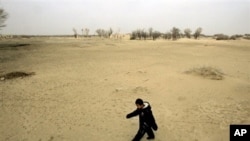There has always been some form of migration due to changes in climate, but scientific research reveals the number of so-called environmental migrants is growing.
“Whether it's on account of natural disasters or impacts of climate change, people are moving away from areas as they become wetter or drier, or as temperatures increase."
said Jane McAdam, author of Climate Change, Forced Migration, and International Law.
A compilation of four years of research, her book critically examines whether states have obligations to protect people displaced by climate change,
"Most environmental migration is within countries rather than across borders, but governments rarely determine who is on the move or why," said McAdam, who is also Director of the International Refugee and Migration Law project at the Gilbert + Tobin Centre of Public Law at Australia's University of New South Wales.
McAdam's research offers several reasons that prompt internal migration – primarily from rural to urban areas.
“People may say it's for work or because climate change has made it difficult to maintain a farm," McAdam said. "They may also say the move is for family reasons."
In Bangladesh, McAdam interviewed people living in the slums of Dhaka who offered a variety of stories about why they had come to the capital.
"They often cited changing weather conditions as the underlying reason for them leaving rural areas for the city," McAdam said. "In Bangladesh, where many areas are prone to heavy flooding, people have hardly any choice but to move to a region where they can feel safer."
For some people, moving is not an option. “Those who are so marginalized or under-resourced may be among the most vulnerable of all,” McAdam said.
“Whether it's on account of natural disasters or impacts of climate change, people are moving away from areas as they become wetter or drier, or as temperatures increase."
said Jane McAdam, author of Climate Change, Forced Migration, and International Law.
A compilation of four years of research, her book critically examines whether states have obligations to protect people displaced by climate change,
"Most environmental migration is within countries rather than across borders, but governments rarely determine who is on the move or why," said McAdam, who is also Director of the International Refugee and Migration Law project at the Gilbert + Tobin Centre of Public Law at Australia's University of New South Wales.
McAdam's research offers several reasons that prompt internal migration – primarily from rural to urban areas.
“People may say it's for work or because climate change has made it difficult to maintain a farm," McAdam said. "They may also say the move is for family reasons."
In Bangladesh, McAdam interviewed people living in the slums of Dhaka who offered a variety of stories about why they had come to the capital.
"They often cited changing weather conditions as the underlying reason for them leaving rural areas for the city," McAdam said. "In Bangladesh, where many areas are prone to heavy flooding, people have hardly any choice but to move to a region where they can feel safer."
For some people, moving is not an option. “Those who are so marginalized or under-resourced may be among the most vulnerable of all,” McAdam said.







